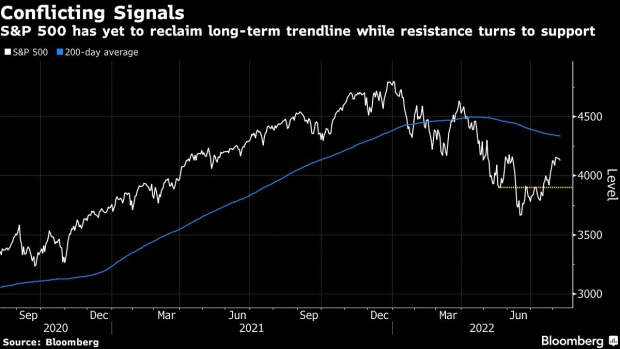Aug 9, 2022
Strategists Under the Same Roof Clash on S&P 500 Before CPI Data
, Bloomberg News

(Bloomberg) -- The $5 trillion rally in US stocks: a new bull cycle, or yet another mirage? Evidence is so divergent that even professional forecasters at the same firm can’t agree. Stakes are sky high with the most-scrutinized economic report in the world about to land.
At Evercore ISI, the head of technical analysis, Rich Ross, just pronounced the 2022 bear market is over, citing everything from chart patterns to peak inflation and investor sentiment. The next 500 points on the S&P 500 will be higher, he says.
Julian Emanuel, the firm’s chief equity and quantitative strategist, is less sanguine. Unless the benchmark index breaks above 4,340 -- a level near its average over past 200 days -- the market is vulnerable to fresh lows amid lingering economic and policy risk.
The direction hinges on what happens with inflation -- a data point whose path virtually no one has accurately predicted since the Federal Reserve rushed to rescue the economy from the pandemic shutdown. Wednesday will bring the latest reading at a time when markets have rarely been more baffling, as investors try to figure out the path and impact of central bank policy and strategists continue to deliver a shockingly wide range of outlooks.
“I don’t really wish to call attention to the differences, though they are, of course, real,” Emanuel said in an interview. “Clients were universally bearish in June and even to July and now the overriding emotion is, in fact, one of confusion.”
Stocks fell for a fourth straight day, with the latest drop following another downbeat outlook from a giant chipmaker. The S&P 500 slipped 0.4% to 4,122. The Nasdaq 100 lost 1.1%.
The diverging views at Evercore highlight the wide range of opinions on Wall Street. In the latest Bloomberg survey of strategists, the highest year-end target points to a gain of 24% for the S&P 500 from Tuesday’s close, while the lowest forecast calls for an 18% drop. The gap is among the widest on record.
It’s a murky backdrop ahead of the inflation data, an event that hasn’t been kind to stock investors this year. The S&P 500 has fallen every time it’s been released as consumer prices came in mostly hotter than expected.
The CPI probably increased at an annualized rate of 8.7% in July, according to a Bloomberg survey of economists. While that’s down from a four-decade high of 9.1% in June, it’s way above the Fed’s 2% inflation goal.
“If inflation is still a big problem in September, October, November, December, the markets are probably going to be lower than they are today,” said Brian Nick, chief investment strategist at Nuveen. “The Fed is determined to lick inflation.”
Before this week, stocks had enjoyed a stretch of gains that lifted the S&P 500 13% from its June low and propelled the Nasdaq 100 to the brink of a 20% rally. Behind the rebound were better-than-expected corporate earnings and economic data that eased recession fears.
From meme stocks to tech bellwethers, gains spread across the market, with breadth indicators flashing bullish signals. And levels that were resistance just weeks ago have turned into support.
Improving chart patterns, along with signs of easing inflation and “uniformly bearish” positioning among institutional investors, are all evidence to Evercore’s Ross that the equity rout is likely over.
“The biggest moves tend to occur at turning points and prices get better before the headlines and the fundamentals,” he wrote in a note Monday. “A cyclical bull market has begun which will involve a breakout to a marginal new high.”
The swift market recovery has forced some rule-based quant traders to close their bearish wagers, a move that in turn added fuel to equity gains. Though broadly, caution prevails.
In a client survey conducted last week by Wolfe Research during a webcast, 75% of the participants said the S&P 500 has yet to reach a bottom.
Chris Senyek, Wolfe’s chief investment strategist, shares the skepticism. The way he sees it, investors betting on a friendly Fed are bound to face a moment of reckoning that the central bank will keep monetary policy tighter for longer. While earnings turned out to be better than feared, a downgrade cycle is under way, making what looks like reasonable valuations harder to justify at a time when interest rates are heading higher.
“This has been a bear-market rally, not a new bull market,” Senyek said.
As clouded as the fundamentals are, the vigor of this rally is starting to resemble past bull markets. As of Friday, the S&P 500 retraced more than one third of its peak-to-trough decline over 34 days with double-digit gains -- a feat seen only 13 other times since 1947. With the exception of three, all those instances took place during bull cycles, according to data compiled by Sundial Capital Research and Bloomberg. And all but one saw stocks higher 12 months later.
“An impressive retracement means it’s less likely to fail,” said Jason Goepfert, chief research officer at Sundial. “This probably isn’t just a bear market rally.”
©2022 Bloomberg L.P.





